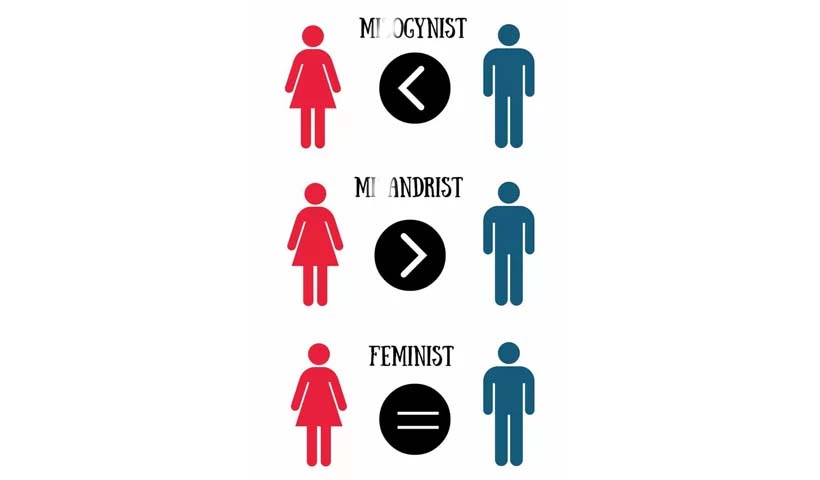The era post World War II witnessed the demonization of the Nazi soldier archetype; the model of males concentrated on powerplay and violence capable of mass destruction. This was the instance where the equality of sexes and breaking of gender roles occurred as females took the roles of the males of their households, so as to fill the void of mundane activities as their sons, husbands or brothers left to fight the war against Germany. The unique period, with experimentation with traditional roles and a newfound sense of responsibility and freedom for women, led to the early footprints of the movement, ‘Feminism’. This is an important clue to the whole discussion going to follow; as an unexpected wave of hate and prejudice towards males was brewing in the corners.
The menace of ‘misogyny’ has existed for ages as it likely arose at the same time as patriarchy: three to five thousand years ago at the start of the Bronze Age; this was the period where male Gods began replacing matriarchal religions. The notice of the violation of human rights as per the mentioned practice was taken in the first wave in the late nineteenth and early twentieth centuries, emerging out of an environment of urban industrialism and liberal, socialist politics. The goal of this wave was to open up opportunities for women, with a focus on suffrage; followed by another three waves, naming it the ‘Four Waves of Feminism’.
In the 1980s, the term misandry started to be used in men’s rights literature and academic literature on structural prejudice. It acted as a counter-movement to feminist claims of misogyny and repression on emotional, social, and economic levels gaining a criticized status; but later on, it started becoming comprehensive with citations in literature, psychology, and gender studies papers.
PSYCHOLOGICAL EXPERIMENT:
Glick and Fiske developed psychometric constructs to measure the attitudes of individuals towards men in their ‘Ambivalence toward Men Inventory’, AMI, which includes a factor ‘Hostility toward Men’. These metrics were based on a small group discussion with women which identified factors, these number of questions were then reduced using statistical methods. Hostility toward Men was split into three factors:
- Resentment of Paternalism, the belief men supported male power,
- Compensatory Gender Differentiation, the belief that men were supported by women and
- Heterosexual Hostility, which looked at beliefs that men were likely to engage in hostile actions.
These can be considered leading factors of discussion in the tussle between Feminist and Androphobic notions. The combined construct, ‘Hostility toward Men’, was found to be inversely correlated with measures of gender equality when comparing different countries and in a study with university students, self-describing feminists were found to have a lower score.
The results show us that the levels of equality among sexes is proportional to the well-being of men; as awareness towards heterosexual harmony leads to awareness of minimizing general violence rates.
The studies have also found that hostilities towards males are primarily conducted through other males, due to pressure from the environment, the grooming of society to be less emotionally aware and expressive, induction of models like ‘violent valor is masculinity’, and ego grooming of action over compassion. Unfortunately, many young males fall victim to this mindset, affecting their mental health and harmony.
CONFUSION IN THE TERMINOLOGIES:
The feminist arguments are generally accused of being misandry supporting, the misandry arguments are similarly accused of being misogynistic statements and the misogynistic remarks are naturally as condescending in nature as misandry remarks are, but are not followed well; this represents the lack of understanding of these terminologies.
The etymology of Feminism traces to ‘the celebration of the feminine element, biologically and in the nature of existence as well’, but the definition developed since The Renaissance and the in present context differ. As it indicates the right of females to ‘equalism’, which refers to ‘cerebral equality’ between sexes.
In the course of understanding misandry, men’s rights activists and other masculinist groups have criticized modern laws concerning divorce, domestic violence, the draft, circumcision (known as genital mutilation by opponents), and treatment of male rape victims as examples of institutional misandry. The greatest drawback of contempt against men is indeed the decreased quality of life for the males, where the cases of ‘male sexual abuse victims’ are highly repressed by media, degraded by society, and do not receive the deserved consideration and sympathy; hinting towards the ‘massive desensitization towards the breadwinner complex on males’ where physical strength in the society is glorified to toxic standards.
Other examples include social problems that lead to men’s shorter lifespans, higher suicide rates, requirements to participate in military drafts and lack of tax benefits afforded to widowers compared to widows.
On the contrasting side, ‘misogyny’ takes shape in multiple forms such as male privilege, patriarchy, gender discrimination, sexual harassment, belittling of women, violence against women, and sexual objectification. The roots of misogyny can be traced as long as to ancient Greek mythology. The complexity of these three terms, rather than being opponents, are cues to the collective problem of misinterpreted sexual dichotomy.
THE TRUTH – COLLECTIVE:
The efficient functioning of a society is based on the coordination of communities, nationalities, fields, and diversities as well as the primary biological distinction in human beings, men and women. Mankind’s instinct for survival, intelligence, empathy, and the connection is higher than the above differences as every male individual possesses the power of ‘Anima’ (the feminine creative element) and every female individual possesses ‘Animus’ (the masculine creative element). This portrays the concept of Yin and Yang residing in each of us, which is the perfect balance of both energies. We, as a society need to reflect on the adversities faced by the people on the grounds of natural biology and inculcate mutual respect for the other gender instead of misinterpreting the context of such social phenomena.
Also Read: Shiva and Shakti symbolize male and female equality
Article by – Ananya Behera

Please Read the Article Submission and Our Editorial Policy for More Information Regarding this user account!!

